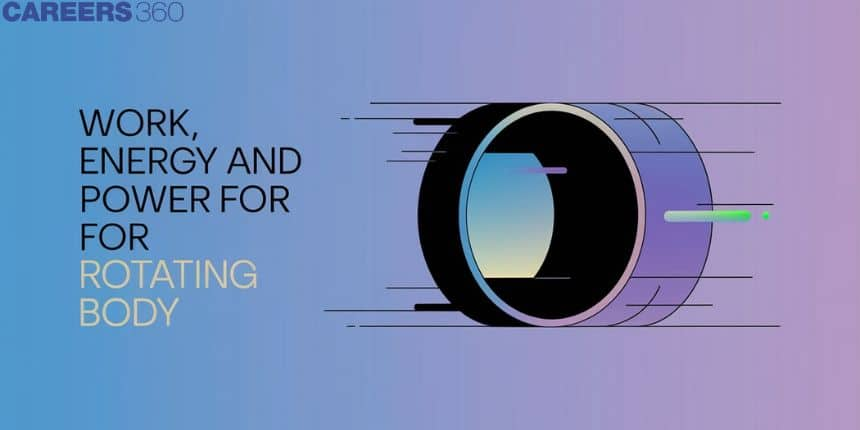Work, Energy And Power For Rotating Body
Understanding how things move and work is important in everyday life. When we talk about rotating bodies, we mean objects that spin around, like the wheels on a bike, the blades of a fan, or even the Earth itself. Just like pushing a cart requires effort (or work), making something spin also requires work. This work gets stored as energy in the rotating object. The faster or harder it spins, the more energy it has. Power is about how quickly this energy is used or transferred.

Think about a windmill: the wind works to turn the blades, storing energy in their rotation, which can then be converted into electricity to power our homes. Or consider a car: the engine does work to make the wheels spin, giving the car energy to move. By exploring these concepts of work, energy, and power in rotating bodies, we can better understand how many of the tools and machines we use every day operate and make our lives easier.
What is Work?
For translation motion W=∫Fds
So for rotational motion W=∫τdθ
What is Rotational kinetic energy?
The energy a body has by virtue of its rotational motion is called its rotational kinetic energy.
Difference between Rotational kinetic energy and Translatory kinetic energy
Rotational kinetic energy | Translatory kinetic energy |
| KR=12Iω2 | KT=12mV2 |
| KR=12Lω | KT=12PV |
| KR=L22I | KT=P22m |
What is Power?
Power is equal to the rate of change of kinetic energy. It's denoted by P.
For translation motion P=F→⋅V→
So for rotational motion
P=d(KR)dt=d(12Iω2)dt=Iωdωdt=Iαω=τ⋅ω Or P=τ→⋅ω→
We can understand better through video.
Solved Example Based on Work, Energy and Power for Rotating Body
Example 1: A stationary horizontal disc is free to rotate about its axis. When a torque is applied to it, its kinetic energy as a function of θ, where θ is the angle by which it has rotated, is given as kθ2. If its moment of inertia is I then the angular acceleration of the disc is :
1) k4Iθ
2) kIθ
3) k2Iθ
4) 2kIθ
Solution:
kE=kθ212Iω2=kθ2ω2=2kθ2Ia=dωdθ2ωdωdθ=2k2θIdωdθ=2kθIωa=2kθIω
angular acceleration
α=aω=(2kθIω)=2kθI
Hence, the answer is the option (4).
Example 2: A particle performing uniform circular motion has angular momentum L. If its angular frequency is doubled and its kinetic energy halved, then the new angular momentum is :
1) L/4
2) 2L
3) 4L
4) L/2
Solution:
We know that L=Iω
K.Erot =12Iω2LK=2IωIω2⇒>LK=2ω=>L=2Kω∴L1L2=K1K2×ω2ω1=2×2=4L1L2=4⇒>L2=L14=L4
Hence, the answer is the option (1).
Example 3: A wheel is rotating freely with an angular speed ω on a shaft. The moment of inertia of the wheel is I and the moment of inertia of the shaft is negligible. Another wheel of the moment of inertia 3I initially at rest is suddenly coupled to the same shaft. The resultant fractional loss in the kinetic energy of the system is :
1) 56
2) 14
3) 0
4) 34
Solution:

By angular momentum conservation
ωI+3I×0=4Iω′⇒ω′=ω4(KE)i=12Iω2(KE)f=12×(4I)×(ω4)2=Iω28ΔKE=38 Lω2
fractional loss =ΔKEKE1=38Iω212 Tω2=34
Hence, the answer is option (4).
Example 4: A disc with a flat small bottom beaker placed on it at a distance R from its centre is revolving about an axis passing through the centre and perpendicular to its plane with an angular velocity ω. The coefficient of static friction between the bottom of the beaker and the surface of the disc is μ. The beaker will revolve with the disc if:
1) R≤μg2ω2
2) R≤μgω2
3) R≥μg2ω2
4) R≥μgω2
Solution:
The beaker will revolve with the disc if friction force is able to provide the necessary centripetal force

f≤μmgmv2R=mRω2⩽μmgR⩽μgω2
Hence, the answer is option (2).
Example 5: A disc of mass 1 kg and radius R is free to rotate about a horizontal axis passing through its centre and perpendicular to the plane of the disc. A body of the same mass as that of the disc is fixed at the highest point of the disc. Now the system is released when the body comes to the lowest position, its angular speed will be 4x3R rad s s−1 where x= (g=10 ms−2)
1) 5
2) 6
3) 7
4) 8
Solution:

As the system is released and comes to the lowest position
TEinitial =TEfinal Mgh+0=12I2Mg(2R)=12(MR22+MR2)ω28MgR=3MR2ω28 g3R=ω16x=8 g=80x=5
The value of X is 5
Summary
Work is done on a body only if the following two conditions are satisfied:
- A force acts on the body
- The point of application of the force moves in the direction of the force.
There are two types of energy in a rigid body: kinetic energy and potential energy. The energy of a body is measured by the amount of work the body can perform. Energy has several forms.
Frequently Asked Questions (FAQs)
Also Read
02 Jul'25 07:48 PM
02 Jul'25 07:47 PM
02 Jul'25 07:41 PM
02 Jul'25 07:14 PM
02 Jul'25 07:11 PM
02 Jul'25 06:25 PM
02 Jul'25 06:25 PM
02 Jul'25 06:14 PM
02 Jul'25 06:14 PM
02 Jul'25 06:14 PM